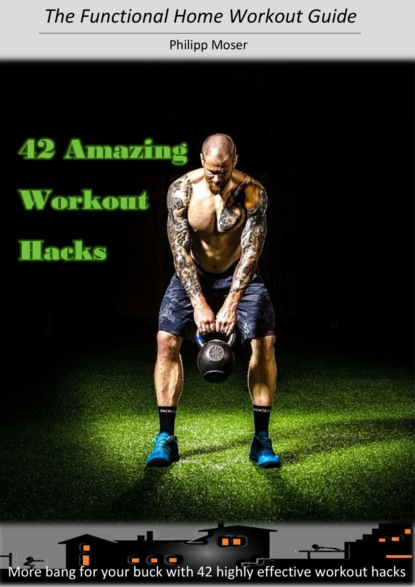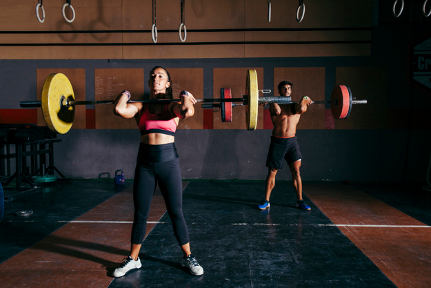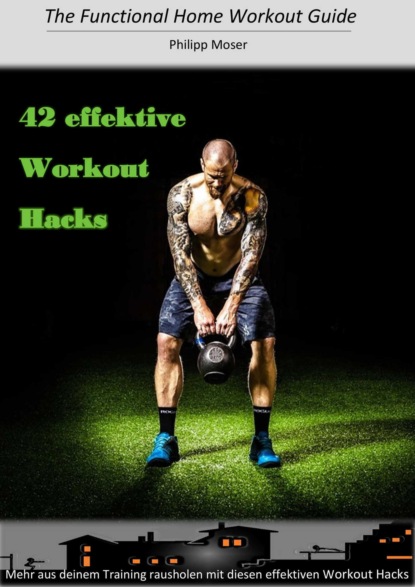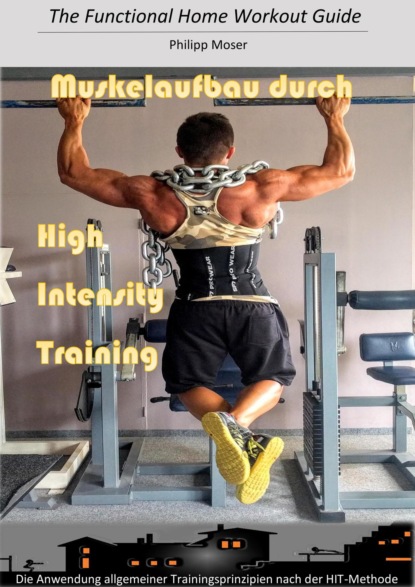42 Awesome Workout Hacks

- -
- 100%
- +

Philipp Moser
42 Awesome Workout Hacks
More bang for your buck with 42 highly effective workout hacks!
Dieses ebook wurde erstellt bei

Inhaltsverzeichnis
Titel
Introduction
Why exercise?
Before we train
Hacks to improve your workouts
Conclusion
About the author
Impressum neobooks
All over the world there are millions of people working out on a regular basis, but not getting the desired results. They got sold on outdated rules of thumb, false claims about nutrition or training methods or just plain, foolish bro-science. A lot of us were told to do X and then Y will fall into place. And if it still didn’t happen, well, keep on pushing until the desired results kick in. As an experienced personal trainer, trust me when I tell you this: If it hasn’t worked out for you until now, your routine will never get you to accomplish your goals in the gym. Everybody is different: different metabolisms, different limb-torso-ratios, different muscle attachment points, our hormone systems operate differently, heck, we don’t even have the same muscles! First, everybody has his or her distinct ratio of slow twitch and fast twitch muscle fibres, which defines if you are more prone to add mass easily or if you are bound to stay rather lean. Second, there are even muscles that can only be found in certain people (e.g. plantaris muscle, psoas minor muscle). So, chances are that you will have to experiment a lot over and over again until you find the exercises, techniques and rest intervals until you find out what has the potential to really help you achieve your gym goals – be it more strength, more mass, overall athleticism or just building a more appealable physique. The only proven method to improvement is to test, apply and then re-test. There are simply too many variables to consider! Science has done a great job so far in explaining different mechanisms of the body and how they react to certain types of training, but in any study you can only control a few variables. When you work out, dozens, if not hundreds of variables work together in a complex way to lead to a certain metabolic response to your training session.
This book primarily addresses experienced lifters and people who have been working out at home for at least a year. Most of the stuff you will read about requires a good physical foundation. If you are looking for new inputs to break through plateaus, this book is here to give you more options. More options to work on hypertrophy, more options to sneak in a quick workout on the go, more options to work on strength and to improve recovery. Be ready to flip your workout philosophy upside down if it hasn’t yielded the results you have been waiting for. Be curious enough to try out some completely different approaches to training. Be willing to try new stuff and dump it if it doesn’t work – but at least give it a fair shot for about six to eight weeks. Be all that, but don’t believe anything I tell you! Be open to new ideas inside and outside the gym and be convinced by what works for you! Work, sweat, repeat...and have fun with the process!

Why exercise?
My guess is that you first started exercising because you just wanted to transform your body composition. And I don’t blame you for that, I did as well. Who doesn’t want to look sexy and attract certain people into their lives. So basically, if you were not told by your doctor, you most certainly started working out by being a bodybuilder. But building a leaner, more muscular body is not the only reason people seek to throw some weights around. As experience grows, demands grow. Some people want to tap further into their strength potential, others wish to be more athletic and agile on the playing field. Others only want to get rid of that goddamn back pain that had been troubling them for years and years. For quite a few people working out is an excellent way to meet new people or have fun with family and friends. You get the idea! There are many good reasons to invest time in your physical health and before we kick it off I’d like to share with you some of the benefits of moving weight regularly.
By working out you can massively increase your strength in any desired body part. Studies have shown that it is possible to at least double your strength levels within the first one to two years of training. Think about it: babies and toddlers only become stronger by applying forces against gravity by crawling, rolling, squatting and playing all day. So, imitating your kid’s movements (if getting in those positions is still possible) is one of the most basic and easiest workouts you can do to improve strength and mobility. Imagine the potential for strength when your body is dealing with progressive overload induced by (free) weights or more challenging lifting techniques!
With increases in strength you will usually also see an increase in muscle volume (hypertrophy). Hypertrophy kicks in, when the existing muscle volume fails to meet its demands. Progressively increasing the weights being moved, forces the body to innervate more and more muscle fibres. If the quality and quantity of the working muscles becomes insufficient to handle the load, the body is forced to adapt in a way that makes bearing such a load possible in the future. One of these adaptions is the physical growth of muscle tissue, also called hypertrophy. But the potential for growth is strongly correlated to your ratio of fast twitch muscle fibres compared to slow twitch muscle fibres. So lean, slow twitch, ectomorph people – usually with a tendency to favour endurance sports – must train and eat totally different compared to folks with a fast twitch surplus. But hypertrophy is possible for both body types and at all ages.
The single best thing to do to keep your bones healthy is to move against resistance or to lift heavy weights. Of course, walking and running also have their benefits, but lifting high loads at least twice a week improves bone density dramatically and serves as the best protection against osteoporosis. Bone mass peaks between age 30 – 40 before it starts its steady decline. You could either raise your bone mass to a higher density before that to draw from such a density advantage later in life, or at least slow down its decay after age forty by working out. Some studies have shown that it is even possible to increase bone density in later years, if people start working out and stick to a well-rounded routine.
Did you know what holds your joints together? No, it is not bones. Rarely do bones have physical contact to each other in the big joints of the limbs and torso. Joints are held in place by muscles, ligaments and joint capsules. All those structures experience positive effects if you exercise with enough weight, in the right movement form and if you give them the recovery time they need. That said, joint stability improves due to proper regular workouts, which can be crucial in any sport or physical activity. The older you get, the more will muscular force, joint stability and mobility determine the quality of your life.
There are still too many people out there thinking that adding muscle mass inhibits their mobility. Nothing could be further from the truth! Look at power lifters or olympic lifters, watch world class gymnasts or sprinters! What do they all have in common? They are pretty mobile, and they are pretty jacked! Applying high forces, either by lifting heavy or by performing quick, athletic movements does not reduce your range of motion. If performed correctly, meaning over its whole range of motion (ROM), any exercise can improve mobility. Lifting through the entire range of motion even prevents muscles from shortening too much and can furthermore increase its length.
More strength, joint stability, mobility and bigger muscles usually also lead to a better posture. This is not only great if your main goal is to improve your looks. A good posture and the ability to keep it well and stable during movement is key to performing on your max in any sport, because it enables you to generate and redirect great forces through your pelvis and upper body and transfer those forces to your limbs efficiently. Furthermore, does good posture protect your spine including your central nervous system (spinal nerves and brain), because those structures don’t like too much movement like flexion and extension. Try bending and extending your neck continuously for a minute. It won’t feel good on the cervical spine and you will feel dizzy after a few seconds.
If you are an athlete, you will like this. It is a proven fact that you can improve your quickness just by lifting harder. Compare athletes’ bodies of any sport over the last few decades and put them in relationship with typical performances of that era. You will discover that throughout the years athletes have become more jacked and way quicker in any sport. No surprise, if we consider that resistance training has become more and more popular and important in college and professional sports since the eighties.
More powerful muscles lead to more physical safety. Of course you won’t be harassed by your neighbourhood bully anymore, take that to the bank! What we are really talking about is the ability to absorb hits in contact sports, the ability to brace your core and joints when forcefully changing direction or decelerating on a dime. The cervical spine, shoulders, knees and elbows are very vulnerable during competition. So, bulking up and strengthening those areas is certainly the best way to prevent drama.
Resistance training will furthermore help you to increase your metabolism and your hormonal balance. Most people will benefit from an increase of local energy storages like ATP, phosphocreatine and glycogen when lifting to failure. Performing circuit trainings, supersets or sets in the range of 10-15 reps and higher can furthermore enhance your lactate tolerance, which in turn increases your capacity to keep intensities up for longer time periods. Your hormonal balance will change for the better, once you start working. More testosterone will not only boost your sex drive, you will produce more human growth hormone (HGH) to facilitate recovery overnight. Well trained people are more resistant to stress because they produce less stress hormones like adrenaline and cortisol in uncomfortable situations. The bottom line is that the allocation of hormones plays a huge role in body composition, mental and physical performance. By exercising and working out you can keep your hormones in check.
That said, also the cardiovascular system benefits from a well-rounded lifting routine. Not only does the heart grow thicker and slightly larger, pumping more blood per minute, thus lowering your resting heart rate. Also, blood pressure adapts to your training, if it is too high it will drop slightly, if too low it will even increase to optimal levels. All this serves one common goal: to get more oxygen and nutrients to the cells that need it in less time and with less work, while improving your blood values.
Today we know that dynamic muscular work can improve blood flow to and circulation in the brain by as much as 50%. Complex, multi-joint exercises with free weights can improve coordination, concentration, short-term memory and therefore neuro-plasticity of the brain. And don’t forget about the positive effects a good looking, healthy and strong body can have on your self-confidence, the way you communicate to others and the way others perceive you. When hard exercise leads to increased lactate release, endorphins flood the system leading to more wellbeing and a better mood during and after the workout.
The older people become, the more they feel restrained by their own bodies. Working out also means taking charge of one’s life and health because it means upping your quality of life – at any age. All the aforementioned benefits will be most important to you, when nature tries to make you feel the wear and tear of a hopefully productive and inspiring life. This is also true for any patient working out to get his or her health back in order. Along with a positive mental attitude, healthy food and one or two cardiovascular workouts (running, swimming, cycling, etc.) per week, lifting your bodyweight or additional poundage is the best drug you can administer to yourself.
Before we train
Assuming you are not a novice to the iron game and your doc did not put you on the injury list or send you to rehab, you are basically ready to go and spice up your workouts. But before you jump right in, I’d like to give you some valuable advice.
Set goals!
In resistance training as much as in any other of life’s endeavours, the mental approach is very important. To really get the results you are after, I suggest you get your pen and paper and define exactly what you want your training results to be. In all detail, with a shipload of emotions tied to your description. More important than the what will be your why. Why do you want to work out in the first place? Why do you want to change some ingredients of your workouts? Why are you willing to push your body in each session? Why will you follow a healthier diet? Why, why, why…?
Just the process of thinking about such stuff, linking the reasons together, and then writing it down, triggers some beneficial processes in your brain. A lot of good stuff happens to your hormone balance, you become more focused and more motivated. You will also start attracting more people, events and situations that help you get what you desire.
All the greats have done it and combined their written statements with regular, inspiring visualisations. Arnold Schwarzenegger could literally see every detail of a winning pose-down years in advance. Desmond Brooks, one of the greatest architects of our time, built his magnificent buildings (like the Bellagio in Las Vegas) out of pure vision in his mind’s eye and sold those projects to his clients by taking them on the same mental trip themselves.
Furthermore, you will need to have a written training plan that comprises all your workouts including the content of those sessions. Start small by setting up a quarterly plan, and when you get a feel for planning, plan half a year or a whole year in advance! What shall be the focus of your workouts at any time of the year? What will be the exercises and rep schemes (although this can be subject to a lot of change due to trial an error)? Try to really work out professionally, hopefully the same way you approach your job! The benefit is not only that you see the incremental steps in advance but that you will also know in hindsight why something worked or did not work, which in turn will make it easier to accurately plan further.
Although goals and reasons why are highly individual, there are three general goals to follow when working out or training for a competition:
Avoid injuries during workout/training!
The worst thing that can happen is to get hurt preparing for games or working out. Why? Because it is totally unnecessary and preventable. There are hundreds of options to keep your workouts save but fun and effective. Unfortunately, humans will find thousands of ways to jeopardize their safety and health. So be thoughtful and don’t jump on every fitness craze or workout bandwagon just because it seems to be hip (e.g. balance training) Most of the time, the most basic and conservative stuff will take you the farthest.
Avoid injuries during competition!
If you compete in any sport, note that it is practically impossible to eliminate the risk of getting hurt during competition! It is just part of the equation – you win something, you lose something! But by properly preparing body and mind for a game, fight or race you really can narrow it down to a few uncontrollable factors. So only when injury avoidance is taken care of, can you progress to the third big goal, which is to increase performance!
Increase Performance!
Now we’re talking! This should mean the most fun to any athlete or weekend warrior. When the workout environment including your routine is set up for safety, you can get out of your comfort zone and work on progressively overloading your system. Before that happens, you only work on stabilizing your structures and getting them used to certain workloads without testing their limits. Once you have done your homework we work with progressions, unusual rep schemes and more intensive methods or learn more complex movements. That’s where real neuro-muscular and mental growth kicks in. But you should always take a step back and think about safety issues along the way!
Please follow those three guidelines in this exact sequence, or else you set yourself up for failure and health issues in the long run. You should train hard, but leave your ego elsewhere for the time being, and concentrate on training smart! That’s why you should also see recovery as a huge part of your plan.
Recovery is key!
Always keep in mind that progress is not only a product of training. Let recovery and nutrition be part of your plan! Your workouts only give the stimulus, but adaptions to that stimulus happen during rest times – preferably during sleeping hours at night. That’s when most of the beneficial hormones are released in their highest quantities. For best results, try to be in bed by 10pm! There are also ways to better time your workouts according to testosterone spikes. We usually experience the highest testosterone levels during the day 3 and 10/11 hours after waking up. If you wake up by six in the morning, around 9 a.m. and then again around 4/5 p.m. would be ideal times for getting your workout in. Avoid working out after eight p.m. because it leads to great deviations in your daily hormone balance and your circadian rhythm, resulting in poor recovery. Nowadays there are many great ways to consciously stimulate recovery: sauna, light cardio work, steam baths, ice water, floating, meditation...but sleep still trumps them all.
Without knowing you, my guess is that your diet could use some upgrade. Most of us consume approximately the same fifteen to twenty foods more than 90% of the time. Usually, variations on our plates are rare, unless you really make an honest effort to bring more colour to your dishes. Mixing up the ingredients of your diet not only fills you up with a greater array of nutrients, but also reduces the risk of suffering from adverse food reactions. Remember that nutrition is the link between performance and recovery and that great abs are made in the kitchen, not in the gym!
Конец ознакомительного фрагмента.
Текст предоставлен ООО «ЛитРес».
Прочитайте эту книгу целиком, купив полную легальную версию на ЛитРес.
Безопасно оплатить книгу можно банковской картой Visa, MasterCard, Maestro, со счета мобильного телефона, с платежного терминала, в салоне МТС или Связной, через PayPal, WebMoney, Яндекс.Деньги, QIWI Кошелек, бонусными картами или другим удобным Вам способом.







